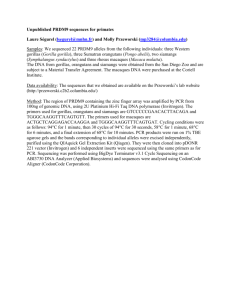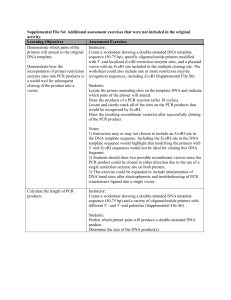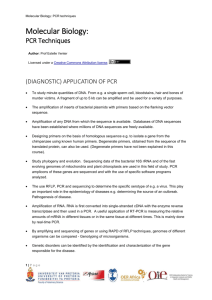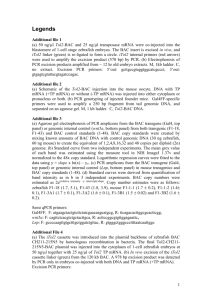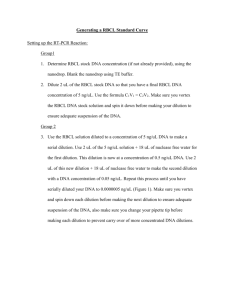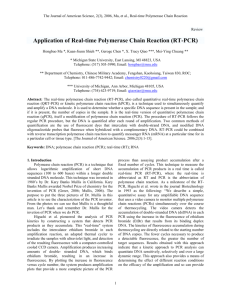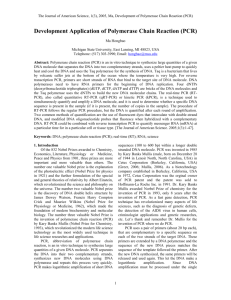emi412167-sup-0001-files1
advertisement
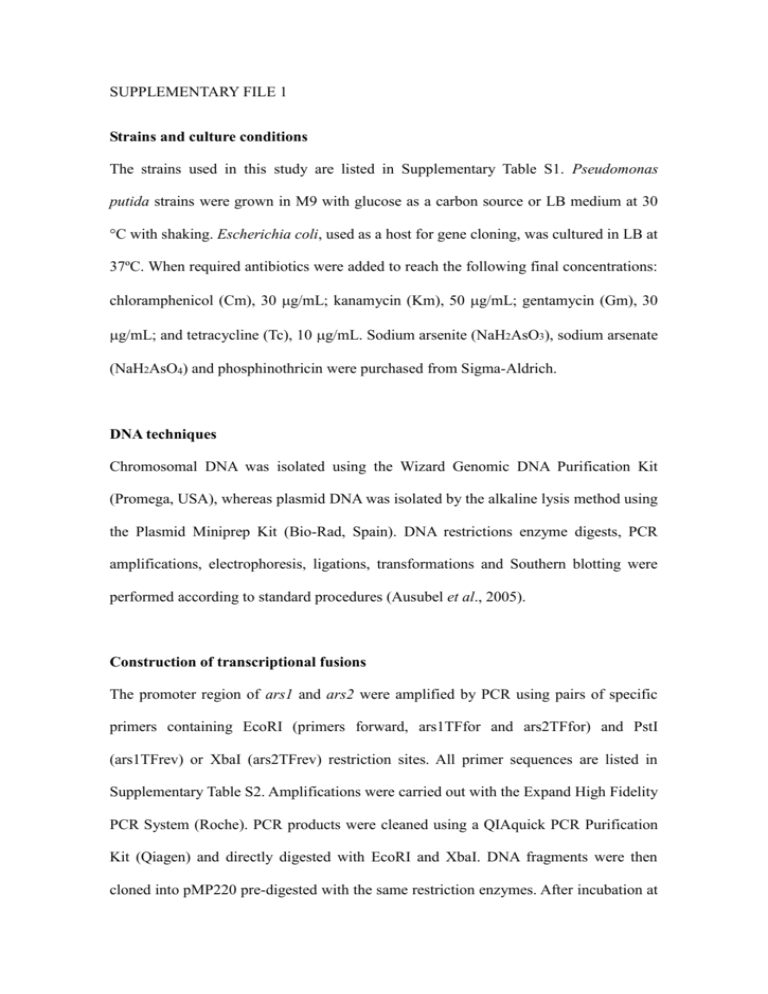
SUPPLEMENTARY FILE 1 Strains and culture conditions The strains used in this study are listed in Supplementary Table S1. Pseudomonas putida strains were grown in M9 with glucose as a carbon source or LB medium at 30 °C with shaking. Escherichia coli, used as a host for gene cloning, was cultured in LB at 37ºC. When required antibiotics were added to reach the following final concentrations: chloramphenicol (Cm), 30 g/mL; kanamycin (Km), 50 g/mL; gentamycin (Gm), 30 g/mL; and tetracycline (Tc), 10 g/mL. Sodium arsenite (NaH2AsO3), sodium arsenate (NaH2AsO4) and phosphinothricin were purchased from Sigma-Aldrich. DNA techniques Chromosomal DNA was isolated using the Wizard Genomic DNA Purification Kit (Promega, USA), whereas plasmid DNA was isolated by the alkaline lysis method using the Plasmid Miniprep Kit (Bio-Rad, Spain). DNA restrictions enzyme digests, PCR amplifications, electrophoresis, ligations, transformations and Southern blotting were performed according to standard procedures (Ausubel et al., 2005). Construction of transcriptional fusions The promoter region of ars1 and ars2 were amplified by PCR using pairs of specific primers containing EcoRI (primers forward, ars1TFfor and ars2TFfor) and PstI (ars1TFrev) or XbaI (ars2TFrev) restriction sites. All primer sequences are listed in Supplementary Table S2. Amplifications were carried out with the Expand High Fidelity PCR System (Roche). PCR products were cleaned using a QIAquick PCR Purification Kit (Qiagen) and directly digested with EcoRI and XbaI. DNA fragments were then cloned into pMP220 pre-digested with the same restriction enzymes. After incubation at 14ºC, ligation mixtures were dialyzed and used to electroporate E. coli DH5. Transformants were selected in LB with Tc. Putative clones were identified using plasmid restriction analysis and subsequently sequenced via the DNA-Sequencing Service provided by the López-Neyra Institute of Parasitology and Biomedicine (Granada, Spain). The resulting constructed plasmids, pMP220::Pars1 and pMP220::Pars2, were electroporated into KT2240 by electroporation. β-galactosidase assays Overnight cultures were diluted 2:100 in LB medium supplemented with different arsenic concentrations and incubated at 30ºC with shaking until they reached the midlog phase (an OD600 of around 0.8). β-galactosidase activity assays were carried out on permeabilized cells and β-galactosidase activity was determined in duplicate and in three independent experiments, as previously described (Miller, 1972). Construction of mutants MiniTn5:Km insertion mutants used is this study were obtained when available from the Pseudomonas Reference Culture Collection (PRCC) (Duque et al., 2007). As no mutant in arsB1 was available from the PRCC, we constructed it via site-directed mutagenesis with pCHESIΩGm. With this aim, an 840 bp internal region of arsB1 was amplified using primers B1for and B1rev. The PCR product was first subcloned into the pCR™2.1-TOPO vector using the TOPO TA Cloning kit (Invitrogen) and then released by EcoRI digestion and subsequently cloned into EcoRI-digested pCHESIΩGm. The ligation mixture was used to transform E. coli DH5, and after the insert was verified, the new construct pCHESIΩGm::arsB1 was electroporated into either into KT2440, to obtain the single mutant, or KT2440_miniTn5:arsB2, to obtain the arsB1/arsB2 double mutant. The presence of an insertion event at the right position was confirmed by Southern blotting. Determination of minimum inhibitory concentration Assays were performed in liquid medium with increasing concentrations of arsenic (arsenite or arsenate) according to the general guidelines of the National Committee for Clinical Laboratory Standards (2003); at least three independents experiments were carried out for each determination and each experiment run in duplicate. Minimum inhibitory concentration (MIC) was determined as the lowest concentration of arsenic that completely inhibited the growth of the strain as evaluated by lack of turbidity after incubation for 18h under optimal conditions. The same technique was used for phosphinothricin resistance determination. 5’-RACE 5'-RACE (rapid isolation of cDNA end) experiments (5´ RACE System for Rapid Amplification of cDNA Ends, Invitrogen) were conducted to map the transcriptional start points of ars1 and ars2 according to the manufacturer’s instructions. KT2440 was grown in LB with 1.5 mg/L arsenite and total RNA was isolated using TRIzol Reagent (Invitrogen); potential DNA contamination was eliminated by two subsequent DNase treatments. Two antisense specific primers, GSP1-ars1 and GSP1-ars2 (Table S2), were designed and used in the first strand cDNA synthesis of ars1 and ars2 respectively, following by a nested PCR with abridged universal amplification primer (AUAP) and either GSP2-ars1 or GSP2-ars2. PCR products were purified by gel extraction and then the amplified sequences were confirmed by DNA sequencing. RT-PCR RNA extraction was performed as described above. Qualitative RT-PCR was carried out using Titan One Tube RT-PCR Kit (Roche) according to the supplier’s instructions. RTPCR reactions were performed at 50ºC for 30 min. All PCRs were run for a total of 30 cycles, using an annealing temperature of 58ºC and the elongation reaction was run for 45 s at 68ºC. Negative controls (no reverse transcription step) were run in parallel to ensure that there was no genomic DNA contamination. Primers used in RT-PCR assays are listed in supplementary Table S1. In silico analysis Visualization of the P. putida KT2440 annotated genome was performed using the Pathway-Tools program. BlastN and BlastP analyses were performed using the Blastall (v.2.2.25) program running in an Intel(R) Core (TM)i 7-2600 CPU 3.40 GHz with 8 Gb of RAM memory running a linux Ubuntu 12.04 operating system. Multiple sequence alignments were performed with ClustalW2 (Larkin et al., 2007) and used to obtain the phylogenetic tree.



